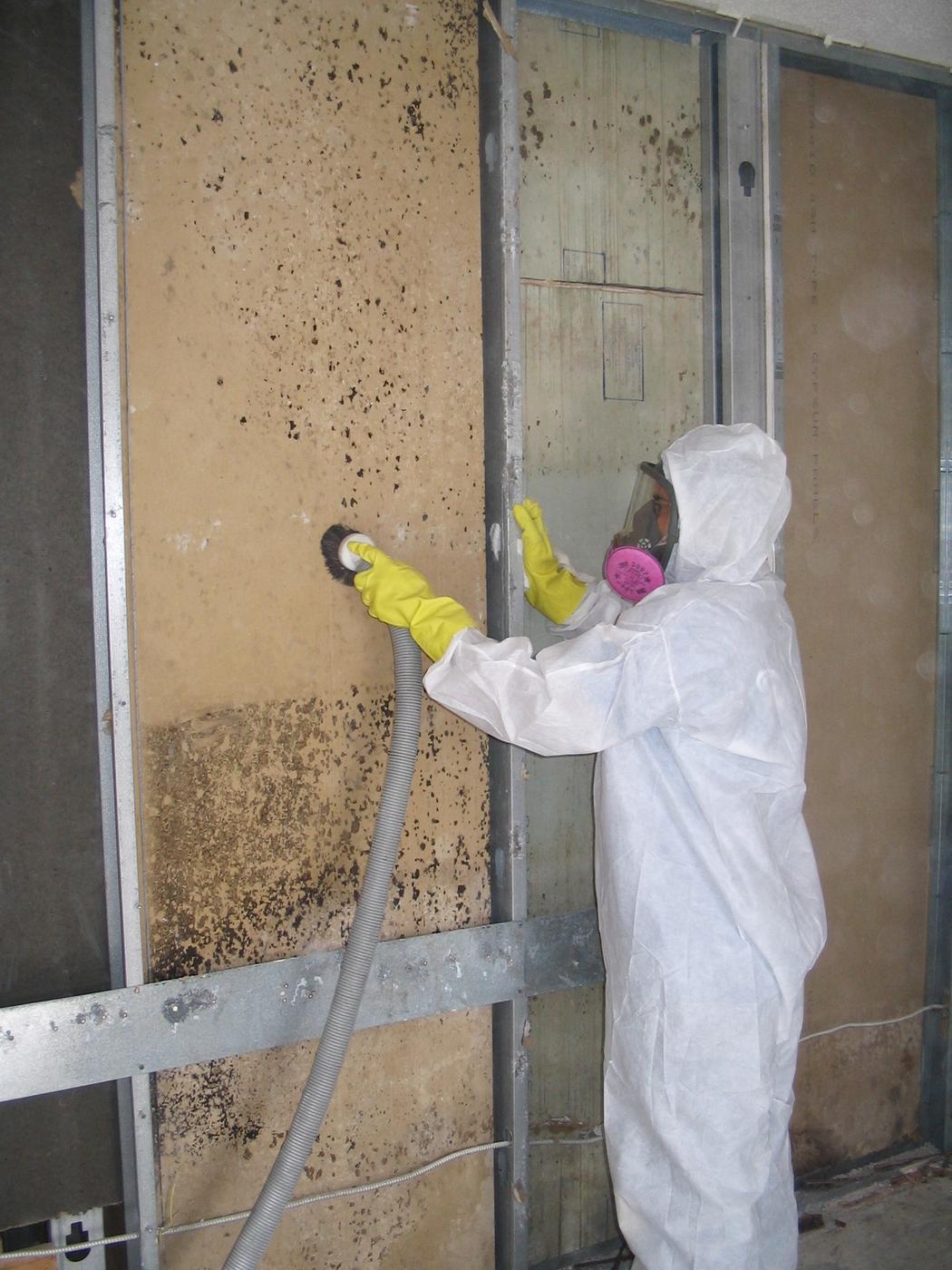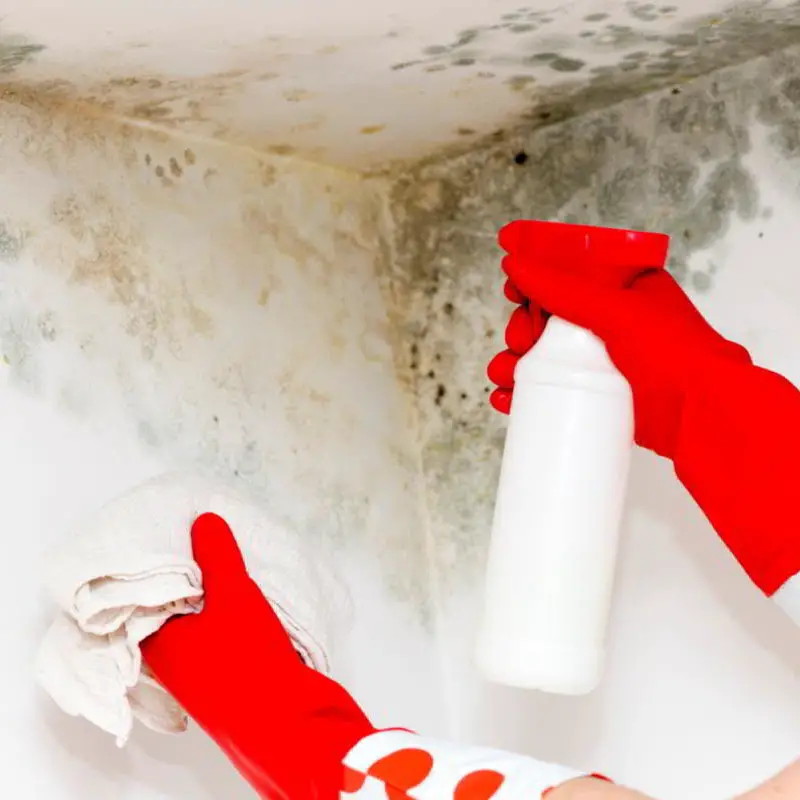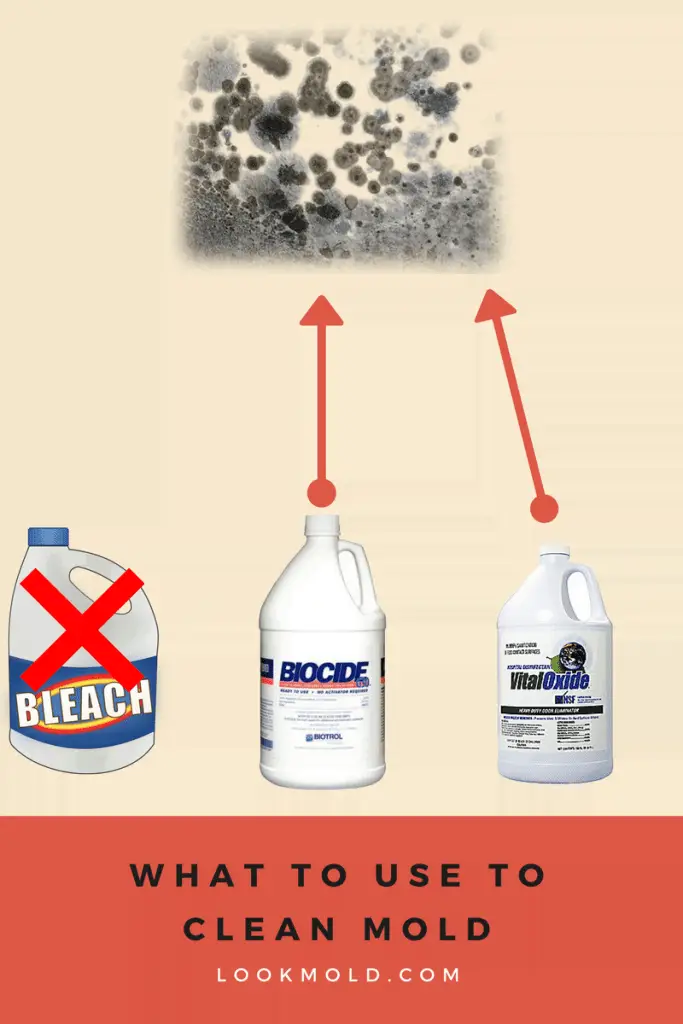If You Have Mold In Your Home
Mold can look like spots. It can be many different colors, and it can smell musty. If you see or smell mold, you should remove it. You do not need to know the type of mold.
If mold is growing in your home, you need to clean up the mold and fix the moisture problem. Mold can be removed from hard surfaces with household products, soap and water, or a bleach solution of no more than 1 cup of household laundry bleach in 1 gallon of water.
Bleach Is Ineffective In The Long Run
In the long run, bleach only helps you mask the mold for a short period. After you have applied bleach to a porous surface, the molds dark green color is removed, and your wall returns to its bright colors. However, the roots of the molds which have reached deep into the insides continue to grow. Also, bleach does not stop harmful mold spores from spreading within the house.
In the long run, you should call an expert to look into any mold problem you have. Cleaning mold is not enough to eliminate their harmful effects because, even when molds are dead, they can still produce toxic spores. Molds have to be removed entirely, and there are different procedures for doing this depending on the type of surface on which the mold has occurred. Air quality also needs to be returned to healthy levels. To achieve these, you should let a certified mold remediation specialist handle any mold problem you have in your home.
How To Prevent Mold
Prevent the growth of mold through the following methods:
- Stop leaks that cause dampness on surfaces. Stopping leaks requires checking around windows frames, roofs, gutters etc., as well as ensuring pipes are joined properly with glue and other adhesives.
- Keep the building ventilated by keeping the windows open and using fans to circulate the air in the building.
- Keep surfaces dry and clean. For instance, users can place a dehumidifier in the basement or laundry room. Keep surfaces dry means keeping humidity levels below 50%.
- Carpeting should not be placed in locations of your house that may get wet like the kitchen or bathrooms. Always dry rugs as soon as they get wet. If already infested with mold, throw them away.
- It is also important not to use too many chemicals on floors as they might damage walls and paintwork that are damp from water leakage.
- Clear and repair any gutters and downspouts to ensure water from the rain flows away from the walls.
If an area has already been contaminated by mold spores, it will be more difficult to prevent future outbreaks from occurring if there are still moisture problems within the house itself.
Still, the best way to remove mold is to call for a mold remediation expert who will assess the source of the mold, the extent of its growth then kills and prevents its regrowth. Clorox can kill mold but its not as effective as what a mold remediation expert will do.
Don’t Miss: How Do You Know If Mold Is In Your House
Getting Rid Of Mold With Grapefruit Seed Extract
Grapefruit seed extract is an effective natural mold killer. It has almost no odor and you can buy it from most health food stores. The citric acid from the grapefruit attacks the mold. It also disinfects the area and deodorizes the area.
Myth #: You Must Clean With Bleach

This isnt true either. Bleach does kill mold, but its hard on your lungs, and it doesnt do a good job of removing mold. Scrubbing with soap and water is a safer and more effective way to eliminate mold from hard surfaces. If porous surfaces like drywall or carpet get moldy, you cant clean them you have to get rid of them. Bleach is necessary only if the moisture that caused the mold is from sewage. In this case, use 1/4 to 1/2 cup of bleach per gallon of water. Scrub the area and leave the bleach solution on for at least 30 minutes before rinsing it off. Thoroughly dry the area afterward.
Also Check: How To Remove Mold From Toilet Tank
How To Remove Mold With Vinegar
Vinegar is natural and safe mild acid that can kill 82% of mold species. Plus it doesnt give off dangerous fumes like bleach. If you want to use vinegar to prevent mold growth on surfaces, spray vinegar on the surface and leave it. Repeat every few days to keep the surface mold-free.
How to Use Vinegar
Using Bleach To Clean To Disinfect Or To Kill Mold In Buildings
Bleaching mold in an effort to kill it, while psychologically understandable, is n ot the proper nor recommended approach to getting rid of a mold problem.
Here we explain why bleach may be satisfying, maybe even useful for cosmetic reasons, but it’s not the right approach to mold remediation.
Our photo at page top shows a moldy home after flooding in Jasper Texas. The drywall and other soft materials needed to be removed, not “sprayed with bleach”. But after all demolition and loose debris cleaning, use of a biocide as a final wash is common in this circumstance.
Our photo at left shows an area for further mold investigation in a basement: the cavity side of paneling in an area that has been damp or wet.
What about a small patch of mold on a bathroom wall or ceiling? This article explains the use of bleach on moldy surfaces.
You May Like: How Long Does Mold Remediation Take
How To Kill Mold With Ammonia
Should You Use Bleach To Clean Mold At All
Experts advise that you should never use bleach to clean mold, whether on a porous or non-porous surface. There are many reasons for this and mainly because, using bleach to treat or clean mold can jeopardize your health.
Common household bleach is not necessarily toxic, but prolonged exposure to bleach can be very harmful to humans. When in the gaseous state, chlorine bleach produces a byproduct called dioxin, recognized as a cancer-causing compound. Hence, inhaling bleach is dangerous.
In addition to this, mixing chlorine bleach with ammonia, drain cleaners, cleansers, or any other similar chemical produces chlorine gas, which can be very harmful to health. Exposure to chlorine gas can cause a burning sensation on the skin, eyes, and nostrils. It can also negatively affect the lungs or cause breathing anomalies, mostly when used around individuals with a lung condition such as asthma.
To stress the potential harm of using bleach to kill mold, the the CDC advises against handling bleach without wearing complete personal protective gear. This includes an N95 respirator to prevent you from inhaling harmful gas, goggles, and protective gloves.
In essence, using bleach to kill mold can cause you even more harm than the mold you are trying to kill.
Recommended Reading: How To Stop Mold Smell In Basement
How To Kill Mold With Bleach
Detoxify Your Top And Front Loading Washing Machine
These instructions are for deep cleaning a washer that hasnt been cleaned in a while , and for detoxifying your washing machine from chemical-based detergents and fragrance. Learn more about the what, whys, and hows of this method in Detoxifying Your Laundry Room. Typically, youll only need to do this once or any time you use chemical-based detergents which we hope you dont have to!
You May Like: How To Remove Mold Under Carpet
Bleach Can Contribute To Further Mold Growth
Bleach is made up of about 90 percent water. Moreover, since molds thrive with moisture, spraying bleach on mold can contribute to further mold growth, especially on porous surfaces.
Once you apply bleach to mold on a porous surface, the chlorine content of the beach dries up almost immediately, leaving behind the water content to be absorbed into the wood or any other absorbent material. The water travels down to the root of the mold and helps it thrive. This is why mold problems often become worse a few days after bleach is applied.
Applying bleach on mold may even cause mold to grow in surrounding areas that were previously unaffected.
How Bleach Works: Information About Disinfectants & Contamination Cleanup Procedures

How does bleach remove stains?
Household bleach is a mixture of sodium hypochlorite and mostly water .
It’s the sodium hypochlorite that’s the active ingredient in bleach. Bleach is an oxidizing and a bleaching agent and a disinfectant. – Grant and Hackh’s Chemical Dictionary, 5th ed.
The chemical formula for sodium hypochlorite is NaClO – or sodium , Chlorine and Oxygen . In NaClO the chlorie atoms are very reactive, snagging electrons from other nearby molecules. Nearby hydrocarbons that comprise organic materials and stains give up electrons to the chlorine while the oxygen and chloride molecules in the bleach stick to the carbons.
Those modified carbon molecules are changed by their new passenge molecules to become highly soluble in water. Water, then, can flush those molecules away – removing the stains. Because the stain particles, now water soluble and now washed away, are physically removed from their original spot, the stain material is actually “gone” – in a favorable reaction.
How does bleach disinfect surfaces, materials, or water?
Bleach is also a really good oxidizer. Its easily-freed oxygen molecule oxidizes molecules that comprise bacteria, fungal spores , other organic materials , and even viruses, or cells within those organisms, thus “killing” them.
The effectiveness of bleaching anything depends on the concentration of bleach and its exposure time. Higher concentrations and longer exposure increase the “kill rate” of bleach when attacking organisms.
Don’t Miss: What To Use To Get Mold Off Walls
Best Cleaners For Vinyl Fence And Siding
Sometimes all the household cleaning products and quick hacks fail to work. Ive been in that situation myself.
And if you too hate seeing your white vinyl fence dirty, dont shy away from using specialized vinyl cleaners. They are quick and effective and will restore shine to your vinyl fence in no time.
Here are four tried and tested options that I trust for keeping my white vinyl white, always.
Does Bleach Or Vinegar Kill Mold
Bleach and vinegar can both kill mold, but vinegar is much more effective for removing mold from porous materials. This is because bleach only kills mold spores on the surface of affected materials. Vinegar will penetrate porous materials and kill the mold at the roots. If you use bleach to remove mold growth, there is a good chance that the mold will return.
You May Like: How To Test For Mold In Basement
This Is How To Clean White Vinyl Fence The Right Way
Vinyl fences are the absolute best.
They dont rot or blister.They are strong and safe.They are easy to install.They are immune to fungus.
And they are not porous. So no way water and air can pass through them.
Plus, my white vinyl fence really adds a sophisticated charm to my garden.
But only after a couple of months of installation, I saw my pristine white fence losing its shine.
And since then Ive tried a bunch of DIY and store-bought products to keep my white vinyl fence white.
Page Contents
Bleach Is Not The Answer For Many Mold Issues
Be honest. What is the first chemical that comes to mind when you think of cleaning up a mold problem? Is it bleach? Chlorine bleach is often regarded as the answer for removing and halting mold growth and is, as such, usually the first thing many reach for when cleaning a mold contaminated area. Yet while bleach may be effective in certain applications, it will not exonerate mold on a porous surface and can actually contribute negatively to certain mold problems. This blog post will explain three reasons why bleach should not be used to combat mold and give better alternatives for you to choose from if you have a mold problem in your home.
Also Check: How To Stop Mold Smell
Using Hydrogen Peroxide To Kill Mold
Hydrogen peroxide is a good alternative to using bleach to kill mold because it is safe and doesnt damage the environment plus it doesnt leave behinid toxic residue or produce toxic fumes like bleach does. Hydrogen peroxide kills mold effectively on materials such as clothing, floors, bathroom fixtures, walls and items such as kitchen appliances.
Bleach Vs Borax For Mold
Both bleach and mold are great for killing mold, but there are pros and cons of each. Borax is a natural mold killer while bleach contains chemical compounds that release toxic gases into the environment.
So, which one is a better mold disinfectant?
Both solutions work as DIY mold killers and can be used almost in a similar way. If you dont have a mold killer yet theres borax or bleach in your pantry, simply use one as an alternative.
To use bleach to get rid of mold and mildew in bathrooms and other places in your house, Add one cup of bleach to one gallon of water. Sprinkle the solution onto the surface with mold and scrub with a soft-bristle brush. Leave the solution to sit for 2-3 hours before rinsing it off.
Pro tip: If you use borax and bleach, you might want to run an air purifier for 24 hours to get rid of the toxic fumes that bleach emits in the house.
Also Check: Does Black Mold Cause Seizures
Dont Take My Word For It
A simple study was conducted by the University of Oregon State. One of the purposes of the study was to examine if bleach can prevent or remove mold growth from Douglas-fir Lumber. The study found that While bleach is often recommended for remediation of surface mold on wood, our results illustrate that the treatment does not eliminate the surface microflora. As a result, an important component of remediation must be drying to moisture levels below 20 percent . In the absence of drying, some fungi clearly survive the treatment and may re-colonize the surface. You can check out the full study here.
What’s More Effective Than 82%

Instead of trying for killing mold with bleach for bathroom mold removal, or using your at-home vinegar remedy, you might want to consider leaving it to the professionals.
The point of mold remediation is to remove the mold in your bathroom in order to prevent human exposure and damage to your home’s building materials and furnishings. It is necessary to clean up mold contamination, not just to kill the mold. After all, dead mold is still allergenic, and some dead molds can be potentially toxic.
There are several different methods used for mold remediation as an alternative to killing mold with bleach for bathroom mold removal. HEPA vacuums are typically used for the final cleanup of remediation areas after materials have been thoroughly dried and contaminated materials removed. HEPA vacuums are also used for the cleanup of dust that may have settled on surfaces outside the remediation area. Mold remediation professionals will take measures during bathroom mold removal to assure that the filter is properly seated in the vacuum so that all the air must pass through the filter. When changing the vacuum filter, remediators will wear PPE to prevent exposure to the mold that has been captured. The filter and contents of the HEPA vacuum will be disposed of in well-sealed plastic bags.
Also Check: How To Get Rid Of White Mold On Plant Soil
How To Remove Mold In Tile Grout Without Bleach
How To Treat Mold With Lemons
Lemons are a natural deodorizer, antiseptic, bleach, stain remover, and cleaner and they can also remove black mold. The high concentration of acid in lemons breaks down mold, making it easy to remove and leaves behind a disinfected surface. Along with that wonderful citrus aroma!
Juice three-to-five lemons into a cup and pour over the moldy area. Let it sit for five minutes and then wipe the surface with a damp towel. You can reapply and scrub the surface to get rid of tough mold stains.
These natural remedies are great non-toxic alternatives to chemical-based black mold removers, and many of them are also effective against mildew. They are safe for your family and safe for the environment, and are frequently less expensive than commercial brands. To learn more about the basics of mold removal, check out this guide from EPA.gov.
From removing mold to weekly housekeeping, The Maids can help you tackle dirt and grime with our full range of cleaning services.
Don’t Miss: How To Mold Leather Holster
